‘We had to go forward’ – The Mountjoy Hunger Strike of 1917
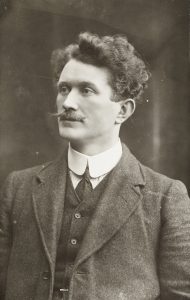
The hunger strike of 1917 and the death of Thomas Ashe. By Dr. Tomás Mac Conmara
Having achieved an historic victory, getting Eamon de Valera elected in the east Clare by-election, republicans, tired from an energy sapping campaign, rose wearily from their beds on 12 July 1917.
Discussions were already underway as to how to capitalise on the victory, when news came through from Kilkenny City that the chief whip of the Irish Party, veteran MP Patrick O’Brien, had died.
The increasingly efficient Sinn Féin political machine was now turned towards the vacant seat in what was then the smallest electoral constituency in the United Kingdom.[1] Sinn Féin required just 772 votes to elect W.T. Cosgrave, the fourth republican candidate in 1917 with a 33 per cent majority, against John Magennis of the Irish Parliamentary Party on 10 August.
As 1917 advanced, the increasing efficiency and self-confidence of the republican movement had clearly disconcerted British authorities
As 1917 advanced, the increasing efficiency and self-confidence of the republican movement had clearly disconcerted British authorities. That a shift in the political landscape was discernible, was evidenced by the formal announcement on 21 May 1917, by David Lloyd George, that an Irish Convention was to be established.[2] The stated objective of the convention was to frame a constitution for Ireland within the British Empire.[3]
The convention was dismissed by Sinn Féin on the basis that the English government had already pledged to support a minority (Unionists) against the majority.[4]
Against the backdrop of the Irish Convention’s development, there was concern within the broader republican movement about the failure of the movement to take decisive action. In south-east Clare, Michael Brennan and his older brother Paddy, were increasingly aware of the potential of such inactivity to damage Volunteer morale.
Reflecting decades later, Michael Brennan revealed ‘We knew that we had to go forward or despite of our efforts we would be dragged back. Public drilling would stimulate interest as the British would have to treat us as a challenge and take action against us’.[5] For Paddy Brennan, an IRB man long committed to the Fenian tradition, a unique and historic opportunity existed. He considered that, while capitalising on by-elections created a frenzy of excitement and energy, something deeper was needed, a more robust and definitive challenge to British authority.
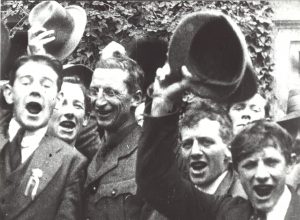
The confrontational East Clare election had illustrated clearly to the Clare Volunteers how overt activity as had been seen in the confrontations of the by-election, could stimulate interest and support in the republican movement.
To capture the hearts and minds of the people, the Volunteers would need to emerge definitively from the shadows. Paddy Brennan summarised the new phase of the Anglo-Irish struggle with just three carefully considered points, which his brother later conveyed as follows:
- Volunteer Units to hold drill parades in public in the presence of the RIC;
- When arrested and charged before a British court, the men were to formally refuse to recognise its authority to try them and they were not to plead nor to make any attempt to defend themselves;
- When sentenced they were to go on hunger strike for political prisoner status.
Critically, this new phase was formulated, articulated and implemented without approval from GHQ of the Irish Volunteers. Once the order was given, Volunteer officers from across the county drilled their companies in full view of the RIC. A new phase in the struggle had begun.
‘Arrests would of course be made’
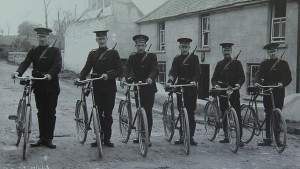
At 5.00am on Thursday 24 July 1917, District Inspector Thomas Philip Barry Townsend ordered his force of twenty-five members of his RIC to forcibly enter the home of Mrs. McNamara on Jail Street, Ennis, County Clare. Inside, the leading figure in the Clare Volunteer movement, who on the previous nights had boldly drilled the Volunteers of Ennis, was asleep.
When the selected unit was given the order to enter, the stillness of the night was shattered by the sound of a smashing door and shouting policemen. Inside, they apprehended the brigadier of the Clare Volunteers, Paddy Brennan.
Some Volunteers decided to drill openly in defiance of the Defence of the Realm Act, in order to provoke a confrontation with the state.
Across the county, at his home in Meelick, his younger brothers Michael and Austin were also arrested at approximately the same time. Brennan and his comrades were accurate in their prediction that ‘arrests would of course be made’. There followed a period of increased Volunteer activity which, as predicted, led to widespread arrests in Clare and across the country.
Following their court martial at Cork Military Detention Barracks, the men were informed that Volunteer HQ would support their position, but were directed to wait until their number had increased to a sufficiently strong number, within Mountjoy prison, where it was established all prisoners were to be sent. In Mountjoy, first-time prisoners were joined by experienced republicans.
Senior rebels, including Ashe, Austin Stack, J.J. Walsh and Fionán Lynch, who had all been involved in serious confrontations at Lewes Jail earlier that year, would be critical as leaders. Joe McDonagh, Seán Treacy and Eamon Ó Duibhir, all from Tipperary, brought significant experience and purpose within the walls of Mountjoy Prison. Soon, the need for structure and defined leadership within the prison was addressed.
Through stolen moments of conversation, in an increasingly restricted environment, the men appointed Austin Stack as their O/C. By mid-September 1917, the republican prisoners had reached sufficient numbers to launch a serious challenge against the prison authorities. The ancient conflict between Britain and Ireland was now condensed within the walls of Mountjoy Prison in Dublin. There, thirty-eight republican prisoners faced down the system of British rule within a new and uncertain arena of struggle, the hunger strike.
‘Now began the days of hunger’
Following court martials, the arrested Volunteers had all been classed as third division offenders, which equated them with thieves, burglars and pickpockets.[6] In defending their actions, the prison authorities claimed they were acting under the regulations imposed by legislation and had to treat them accordingly.[7]
While it is true that contemporary British judicial law did not allow for a special political prisoner status, the committing court had made the decision to classify the men as third division offenders, the lowest criminal level available.
The Republicans imprisoned in Mountjoy went on hunger strike for political status.
While the increasing hostility between republicans and the state militated against any amicable solution, this author’s research demonstrates that the Clare section of the prisoners at least were in little mood for a convivial relationship with their captors. Thirty-eight years later, Brennan looked back on 15 September 1917, when after personally confronting prison wardens, ‘a wild uproar broke out in our wing of the prison, as windows, bed boards and shelves were smashed to the accompaniment of shouting, singing and cheering’.[8]
Brennan held that Austin Stack, the appointed leader of the prisoners, did not approve of these methods and refused to break anything in his own cell. According to Brennan, ‘this did not worry us, as things had gone too far now to be stopped and the hunger strike was on’.[9]
On Monday 17 September, William Boyd, a warder at the prison, reported to Deputy Governor Boland that prisoner 873 had refused to do any work. An ‘Offences and Punishment’ form in the Brother Allen Collection at the Military Archives of Ireland, records the punishment for Tomás Ashe’s insubordination as the forfeit of ‘instructive books for 7 days’.[10]
When Boland recorded the details of the relatively trivial punishment, he could not have envisaged that before it would elapse prisoner 873 would be dead. On the same day, it was agreed that each prisoner would ask to see Deputy Governor John Boland and demand open-air work and free association. This was refused. When he made his demand to Boland, Galway’s Michael Travers was bluntly told ‘Go away and don’t be making a fool of yourself’.[11]
The following day, Tuesday 18 September, the prisoners were deprived of the limited exercise they had been allowed. Art O’Donnell recalled that ‘An order was then issued for the simultaneous ringing of the bells which were attached to the cells’, which were then muffled by the warders.[12] There followed the sound of stools smashing off cell doors and the breaking of cell windows by the prisoners.[13]
What would be one of the most significant and ultimately fatal decisions to be taken in the midst of an admittedly intense period followed. On Wednesday 19 September, one day from the commencement of the hunger strike, John Boland, the acting governor, sent warders into the cells of prisoners to forcibly remove bedclothes, mattresses, sanitary utensils, bibles and boots.[14]
Given the later decision to impose force-feeding, the decision to deprive the men of such basic requirements was to prove significant and ultimately fatal for one prisoner. At 10.00am on Thursday 20 September 1917, thirty-eight prisoners refused to take food.[15] The Mountjoy Hunger Strike had begun. In a deeply emotional treatment of the episode, Seán O’Casey powerfully described that ‘Now the young republicans exert the only power of protest and opposition they have, and the Hunger Strike begins. A few brave hearts against the British State and Constitution’.[16]
‘I felt almost strangled’
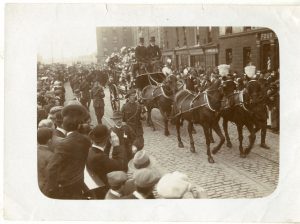
Many of the hunger strikers later recalled the experience, offering an insight into the often brutal and traumatic procedure. Four decades later, Eamon Ó Duibhir explained in an interview how the experience endured for many who went through it:
I never had any fear of hunger-striking, and that was the first one, but I certainly did not like this pipe being passed down through my throat and I began to have a horror of it. I must admit that I was very much afraid of it, and often in years afterwards I woke up and felt this damn pipe or tube going down my neck like a snake.[17]
The prison authorities decided to force feed the prisoners, resulting ultimately in the death of Thomas Ashe.
The process of force-feeding, vividly conveyed to the Irish public in October 1917, during the Ashe inquest, involved being strapped by feet and hands to a chair. The prisoner’s mouth was forced open with a wooden spoon and a tube forced through either the mouth or the nose. An apparatus called a stomach pump (an 18-inch-long rubber tube inserted into a vessel containing milk and eggs) was then used to forcibly feed the prisoner.[18]
To pour the liquid food into the digestive tract of a prisoner took approximately between five and ten minutes. The experience was characterised by Seán Treacy as ‘a sensation similar to tickling the gullet painfully and persistently with a goose quill’.[19]
In a move that would ultimately prove fatal, mid-way through the hunger strike, Dr William Henry Lowe, a local physician, was brought in to help administer force-feeding. Dr Lowe, who had no apparent experience of the procedure, was now drafted into the prison by Dr Dowdall, the chief medic at the prison.
Although admittedly under pressure, the decision of Dowdall, a medical doctor with three decades of experience, to delegate such a potentially dangerous procedure to a wholly inexperienced practitioner, was both reckless and unethical. On Tuesday 25 September, warders arrived at cell 34 in Mountjoy Prison. The tall strong frame of Tom Ashe stood ready. After they opened the cell door, he calmly walked ahead of the warders. By then, he knew where he was going and what was awaiting him. It was 11.15am and in the room where the procedure was to take place, Dr William Henry Lowe was waiting with the stomach pump and nasal tube.[20]
Approximately fifteen minutes later, Ashe was carried back to his cell, blue in the face and unconscious. Hours later, the Kerry republican was dead. Ashe collapsed after food entered his lungs, causing breathing difficulties, and suffered the first of two heart attacks.
After Chief Medical Officer Dowdall became aware of Ashe’s deterioration, he quickly filled out a medical report (housed in the Br. Allen Collection at the Military Archives of Ireland) on which he wrote, ‘the illness of prisoner Thomas Ashe may terminate fatally within a brief period and before the termination of his sentence’.
He drew no correlation between the procedure by Lowe and Ashe’s condition and, instead, recorded that the nature of the Kerry man’s disease was a ‘weak heart’. On the medical form, Dowdall was asked to state whether the disease had been either caused or aggravated by confinement. Strikingly, he responded in the negative to both.[21] Ashe was later taken to the prison hospital and at 5.00pm was removed to the Mater Hospital. There he suffered a second heart attack and died at approximately 10.00pm.[22]
When word reached his family, the predominant emotion was shock and disbelief. A simple telegram, sent by the emerging Volunteer leader Michael Collins, to the Ashe family in Lispole had conveyed a devastating reality to the family.
On 26 September Collins wrote ‘Tom died Mater Hospital 10.30. Have wired Nora’. At 6.35pm on the previous evening, he had hurriedly handed a telegram in at a Dublin post office. On it, he informed Nora that her brother was in the Mater Hospital and that it was ‘advisable you come up tomorrow’. The telegram was received at 7.15pm in Cappamore, Limerick, where Nora was a teacher. By the time she read the telegram, her brother was only hours from death. Nora lamented decades later, ‘It was the last thing we expected to hear that he was dead’.[23]
The ‘September rules’
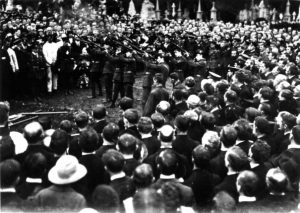
On 29 September, the day before Ashe’s funeral, the Irish Privy Council held an emergency meeting to complete the necessary formalities to allow the General Prisons Board to bring in special rules for the treatment of DORA prisoners.[24]
Irrespective of their relationship to the earlier demands, the granting of these concessions to the Volunteer prisoners represented a significant victory for the republican movement.
As Michael Brennan declared in his witness statement ‘none of the details mattered … the supreme fact was that we had won our fight … This was bound to have a terrific effect on the morale of Volunteers all over the country’.[25] When the terms were confirmed to the internal leadership, the hunger strike was called off on 30 September.
The granting of conditions was published in the national press on 1 October, with The Times in London reporting a ‘Victory for Sinn Féin Prisoners’.[26] Press reports on the concessions, four days after the inquest into the death of Ashe commenced, further damaged British authority in Ireland.[27]
Hunger Striking
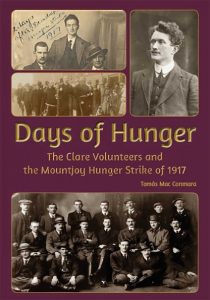 The use of hunger striking was in all ways an uncertain departure for the Irish Volunteers. Ostensibly, hunger striking conflicted with Christian theology in its apparent collision with the sixth commandment. To take one’s own life with the formal and direct intention of taking it, is viewed as suicide and forbidden by Catholic theology.[28]
The use of hunger striking was in all ways an uncertain departure for the Irish Volunteers. Ostensibly, hunger striking conflicted with Christian theology in its apparent collision with the sixth commandment. To take one’s own life with the formal and direct intention of taking it, is viewed as suicide and forbidden by Catholic theology.[28]
Robertus E. Brown, a Catholic priest, argued that hunger strikers were exonerated from charges of suicide on the basis that death was only in the indirect term of this action permitted, not willed.[29] The theological question surrounding hunger striking was heavy with significance in ethical and moral terms.
However, for the general public, the overt symbolism of increasing numbers of priests supporting Sinn Féin, combined with the lack of any clear condemnation of the men from the Catholic hierarchy, conveyed a message of implicit support for the men in Mountjoy. Intricate arguments around morality and doctrine certainly meant little to an assembly at Ennis on 30 September, who listened attentively as Reverend James Clancy roared ‘The blood of Tom Ashe cries to the heavens for vengeance’.[30]
Historically and culturally too, hunger striking resonated with the Irish public through its relationship with Celtic Ireland. Under the Brehon laws, the aggrieved fasted against his debtor by taking up a place close to the debtor’s house and going on hunger strike or ‘troscad’.[31] The powerless were thus afforded, through the Brehon code, ‘athgabal cintaig’, a method of redress, even against the most powerful.[32]
Within the Catholic tradition, St Patrick, the patron Saint of Ireland, hunger struck for forty-five days against God on the Holy Mount.[33] Its codification within the ancient Brehon laws of Medieval Ireland, as well as its place in Irish folk culture, gave the method of protest a moral potency when applied in 1917.
As Dublin mourned Tomás Ashe, British forces could only observe, rendered incapable by such collective anger as had been induced by his death. Henry Duke, the chief secretary of Ireland, subsequently explained to the British war cabinet why the funeral was allowed to proceed as it did.
Duke reasoned that, after consultation with police advisers, he had decided that he could not interfere ‘without provoking the bitterest antagonism and social disorder’.[34] Among the thirty-eight participants on the hunger strike were sixteen men from County Clare, by far the largest representation of any one county.
Examination of RIC monthly returns for political organisations throughout this period, illustrates the growth of the Volunteer movement in the county. In the eight months between June 1917 and February 1918, the Clare Volunteers grew in strength from ten ‘inactive’ clubs with a membership of 425, to thirty ‘very active’ clubs comprising a total membership of 2,125.[35]
The chief secretary’s office ‘Reports on Illegal Drilling’, illustrate also that drilling following the hunger strike, Clare was the worst affected county. For example, of 140 cases of drilling reported nationally in October 1917, fifty took place in Clare. This was ten ahead of Cork, with the rest interspersed in Limerick, Kerry and Tipperary, with isolated incidents in Louth, Westmeath, Longford, Sligo, Wexford, Laois (then known as Queen’s County) and Wicklow.[36]
Reports for the following month indicate an escalation nationally, with 334 cases reported and 114 of those occurring in Clare.[37] The seeming paralysis of British authority in dealing with a patently obvious challenge to its legitimacy, can be directly correlated to the action taken by the Clare Volunteers in July and, in particular, the strategy of Paddy Brennan. A gamble, based on a judgment of the Irish temperament as much as of British policy in Ireland, ultimately paid off.
Tomás Mac Conmara was is an oral historian from County Clare and was awarded a PhD by UL in 2015 for his exploration into the social memory of the Irish War of Independence. In September 2017, he published Days of Hunger, The Clare Volunteers and the Mountjoy Hunger Strike of 1917. See also our interview with him here.
References
[1] Michael Laffan, Judging W.T. Cosgrave (Dublin, 2014), pp 57-8.
[2] Karl F. Geiser, ‘The Irish Convention’, in The American Political Science Review, 12 (1918), p. 293; Laffan, The Resurrection of Ireland, p. 107.
[3] House of Commons Parliamentary Papers, Report on the proceedings of the Irish Convention 1918, p. 36.
[4] Irish Times, 21 May 1917.
[5] Brennan, The War in Clare, p. 26.
[6] National Archives of Ireland, Bureau of Military History, WS 1,322, Art O’Donnell, p. 28.
[7] House of Commons Parliamentary Papers, ‘Fortieth Report of the General Prisons Board (Ireland), 1918-1919, p. 844; Irish Times, 28 September 1917, p. 3.
[8] NAI, BMH WS 1,068, Michael Brennan, p. 27.
[9] Ibid.
[10] Military Archives, Brother Allen Collection, IE/AL/1917/59, Offences and Punishment Form, Mountjoy Prison, 17 September 1917.
[11] ‘Mountjoy, Released Prisoner Relates his Experience’, Clare Champion, 10 November 1917, p. 1.
[12] ‘Death of Thomas Ashe’, An tÓglach, Easter 1961, p. 4.; Gaughan, Austin Stack, Portrait of a Separatist, p. 77.
[13] NAI, BMH WS 1,322, Art O’Donnell, p. 30.
[14] NAI, BMH WS 1,322, Art O’Donnell, p. 30; ÓLuing, I Die in a Good Cause, p. 143.
[15] Tim Carey, Mountjoy, the Story of a Prison (Dublin, 2001), p. 183.
[16] Military Archives, Brother Allen Collection, IE/AL/1917/120, Seán Ó Cathasaigh, The Story of Thomas Ashe (Dublin, 1917), p. 9.
[17] NAI, BMH WS 1,474, Eamon Ó Duibhir, p. 15.
[18] Irish Times, 29 September 1917, p. 8.
[19] Ryan, Seán Treacy, p. 35.
[20] Seán Ó Luing, I Die in a Good Cause, p. 174.
[21] Military Archives, Brother Allen Collection, IE/AL/1917/55, Form of Report by Medical Officer at Mountjoy Prison, 25 September 1917.
[22] Minutes of Ashe Inquest, DE2/507; Ó Luing, I Die in a Good Cause, 172-81.
[23] NAI, BMH WS 645, Nora Ághas, p. 5.
[24] ‘Dublin Castle and Prisoners’, Saturday Record, 6 October 1917, p. 2.
[25] NAI, BMH WS 1,068, Michael Brennan, p. 29.
[26]‘ Victory for Sinn Féin Prisoners’, The Times, 1 October 1917, p. 3.
[27] Irish Times, 1 October 1917, p. 5.
[28] Brian Heffernan, Freedom and the Fifth Commandment: Catholic priests and political violence in Ireland, 1919-1921 (USA, 2014).
[29] Robertus E. Brown, The Ethics of Hunger Striking (London, 1920), p. 9.
[30] ‘Clare Stands for Freedom’, Clare Champion, 6 October 1917, p. 1.
[31] Sweeny, ‘Irish Hungers Strikers and the Cult of Self Sacrifice’, p. 422.
[32] George Sweeny, ‘Self Immolation in Ireland, Hunger Strikers and Political Confrontation’ in Anthropology Today, 9, No. 9 (October 1993), p. 11.
[33] Rona M. Fields, Cóilín Owens, Martyrdom: The Psychology, Theology, and Politics of Self-sacrifice (London, 2004), p. 51.
[34] Seán McConnville, Irish Political Prisoners, p. 614.
[35] NAI, CO 15018/S, RIC Inspector General, Report for the month of June 1917 and for the month of February 1918.
[36] Ibid.
[37] NAI, CO 17422/S, RIC Inspector General, Report for the month of November, 1917.